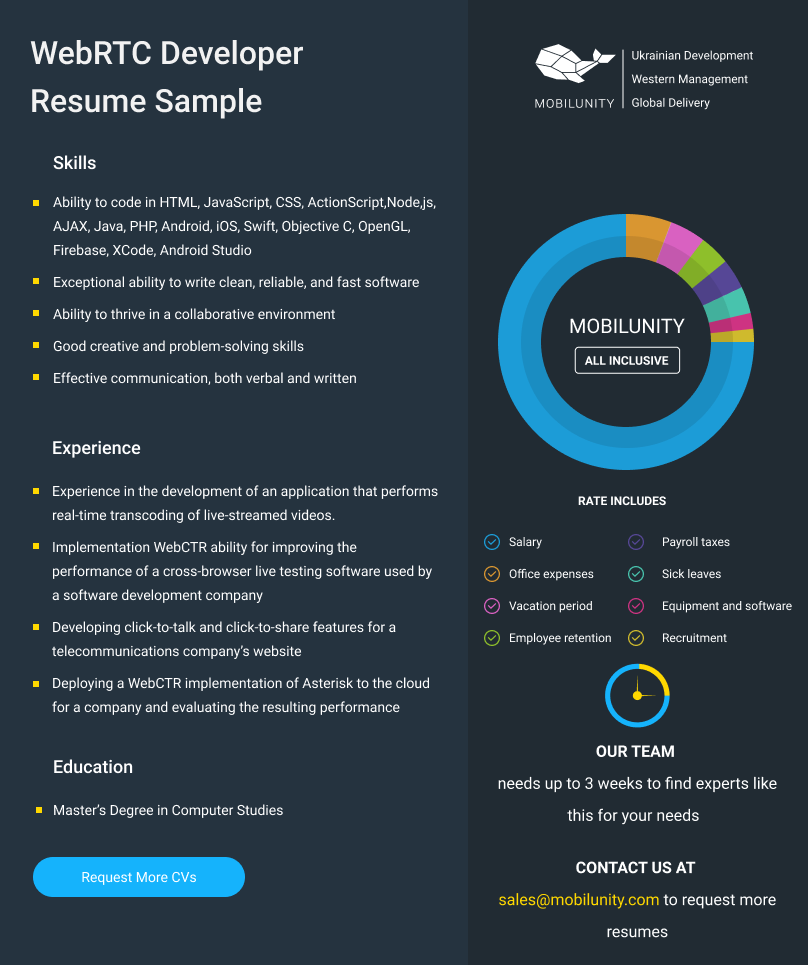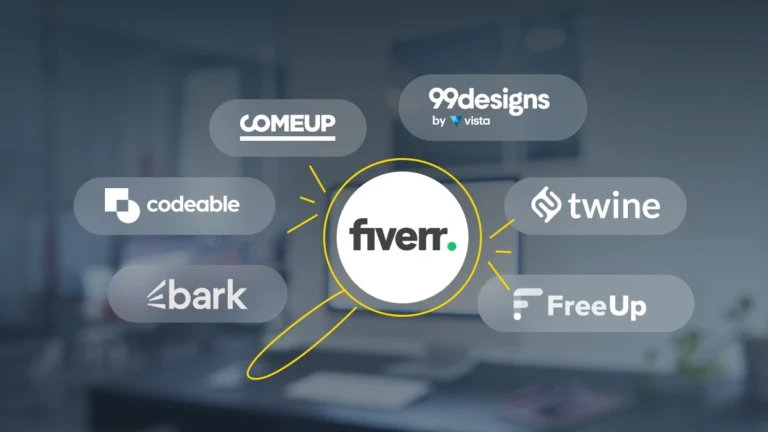Hire WebRTC Developer
Real-time communication has opened an endless amount of possibilities for Internet users to interact with one another. In the past, real-time communication was limited to telephone and mobile phone calls, and these were typically confined to specific regions within the caller’s country. International phone calls were impossibly expensive, and only a small fraction of the population was able to afford this service.
The Internet, however, has revolutionized the way we communicate. Not only has it allowed people from anywhere in the globe to talk practically for free, but it has also allowed other means of communication, such as video calls, live streaming, and instant messaging. In this article, we take a look at WebRTC, a framework that places the power of real-time communication in the hands of WebRTC developers.
WebRTC Overview and Reasons to Hire WebRTC Developer
WebRTC, short for Web Real-Time Communication, is a set of APIs and communication protocols that may be used by WebRTC app developers, including iPhone app developers for hire, to add real-time communication functionalities to web and mobile applications. It enables real-time capabilities such as video and audio calling, instant messaging, file sharing, and video and audio streaming, among others.
What’s special about WebRTC is that it makes use of peer-to-peer (P2P) networks, a network architecture where tasks are distributed among the machines of participating users, called peers, instead of relying on a central server to carry out the task or facilitate its execution. As a result, WebRTC is able to leverage the benefits of P2P applications. For instance, it remains operational even when one or more peer’s machine fails. Moreover, since it doesn’t depend on any mediating server to operate, it enables a web browser of a peer to exchange information directly with the browser of another peer, potentially allowing for faster loading times and shorter delays.

WebRTC generally has two sets of APIs. Its Web APIs contain codes written in JavaScript, which are to be used for web applications and are to be executed on client browsers. Its Native APIs, on the other hand, contain codes to be used for native applications, such as for creating WebRTC mobile native apps for iOS and Android, as well as for creating native desktop applications.
What’s the difference between WebRTC Android vs WebRTC iOS? In a nutshell, WebRTC Android is written in Java, and it may be used and integrated into native Android mobile applications by importing the WebRTC libraries, for which the WebRTC team recommends using Android Studio. WebRTC iOS, on the other hand, is written in Objective C, and may likewise be used in native iOS mobile apps by importing the necessary libraries, for which the WebRTC team recommends using XCode. Note, however, that WebRTC iOS requires the use of a macOS machine.
VoIP Services and VoIP Developers
One particular industry where WebRTC shows a lot of promise is the Voice over IP (VoIP) set of technologies that makes use of the internet to enable people to make phone calls and engage in voice communications. The Australian Communications and Media Authority (ACMA) classifies VoIP services into four types:

- Internet-only – This type of VoIP service connects internet users and allows them to communicate with each other via voice calls. This method relies purely on the Internet Protocol (IP) and does not connect to the public switched telephone network (PSTN), and therefore cannot be used to make traditional calls to landline and mobile phones.
- VoIP Out – This type of VoIP service allows an internet-connected user to connect to the PSTN network to call a traditional landline or mobile phone.
- VoIP In – This type of VoIP service allows a PSTN-connected user, such as one who owns a traditional landline or mobile phone, to connect to the internet and call someone who uses a VoIP service
- Two-way – This type of VoIP service allows two-way communication between a user connected to the PSTN and a user who uses a VoIP service over the internet.
Out-of-the-box, WebRTC comes fully equipped to provide internet-only VoIP services by enabling browser-to-browser communication between users across a peer-to-peer network. With some development work, however, WebRTC may also be used to connect to the PSTN to provide the other three types of VoIP services. This will require a VoIP developer to integrate some signaling protocol, such as, for example, the Session Initiation Protocol (SIP), into the WebRTC implementation to allow it to connect the PSTN.
There are a number of VoIP service providers that may be integrated with WebRTC to allow it to connect to the PSTN. Here are some examples:
Freeswitch
Freeswitch – This is a free, open-source, multi-platform application that provides VoIP and other real-time communication services such as video conferencing, chatting and screen sharing. It comes with direct support for WebRTC, so a Freeswitch developer can quickly integrate it into a WebRTC application to allow browsers to connect to telephone networks.
Asterisk
Asterisk – This is another free and open-source software that provides an implementation of a telephone private branch exchange (PBX), which is a central system that enables multiple local phones to share a few external phone lines by switching calls to different local lines, thereby saving on costs. In addition, it allows the PBX server to connect to the PSTN as well as to VoIP services. An Asterisk developer can add WebRTC functionality to Asterisk by using the SIPML5 APIs to integrate SIP into the WebRTC app.
Vicidal
Vicidial – This is a software suite intended to be used on top of Asterisk to make it suitable for use in contact centers where the volume of calls can get very high and the use of Asterisk alone can result in lost calls and connection problems. It features both inbound and outbound calls, three-way calling, and scheduled callbacks, among many others. A Vicidial developer can integrate WebRTC into Vicidial to allow the use of web browsers for outbound and inbound calls in large-scale contact center environments.
Demand on WebRTC Programmers and WebRTC Experts
If WebRTC and VoIP features appeal to you, then you shouldn’t hesitate to hire highly skilled WebRTC developers. These developers will help embed real-time communication features such as video and audio conferencing and streaming, real-time text messaging, and screen sharing into your web and mobile applications. Moreover, a properly trained RTC developer will be familiar with the industry-standard best practices when it comes to using the WebRTC APIs and protocols, ensuring not only that your app will work, but also that your app will work smoothly and optimally. As the demand for WebRTC continues to grow, now’s a great time to hop onto the technology and use it to grow and expand your business and improve your customers’ experience. For businesses exploring WebRTC development, partnering with a Microsoft Dynamics CRM development company and engaging Symfony developers and Unity 3D programmers for hire can provide a powerful combination of skills that contribute to the creation of secure, efficient, and engaging real-time communication applications.
WebRTC Developer Resume Sample
Here’s an example of an actual WebRTC developer resume to give you a better idea of what the usual skills and background of WebRTC developers typically are:
Hire WebRTC Developer with Mobilunity
WebRTC enables the best WebRTC remote expert to integrate real-time communication features, including VoIP services, into web and mobile applications. It operates over peer-to-peer networks, thereby eliminating the need for intermediate servers to facilitate communication, instead of allowing end-users to connect directly with each other. We’ve examined the capabilities of WebRTC, the various VoIP services, and some VoIP service providers with which WebRTC may be integrated, as well as some details on WebRTC developers. In the context of WebRTC development, engaging a php development offshore expert and understanding the difference between UI designer vs UI developer can help businesses build scalable, responsive, and visually appealing real-time communication applications that deliver seamless user experiences across various devices.
With this information, you’re well-equipped to hire WebRTC developers! If you’re in need of highly talented WebRTC and VoIP developers, look no further, because Mobilunity has what you need to outsource WebRTC developers. We’re a Ukraine-based dedicated teams provider, and we house Europe’s dedicated developers skilled in WebRTC, VoIP, and many other technologies. Not only are Ukrainian WebRTC developers among the best in the continent, but our rates are also among the lowest. For all your development needs, we’ll make sure that you get only the highest quality of service at the most affordable rates.
Contact us now and let’s find you the best WebRTC remote expert and VoIP developer for your project!
Disclaimer: All salaries and prices mentioned within the article are approximate numbers based on the research done by our in-house Marketing Research Team. Please use these numbers as a reference for comparison only. Feel free to use the contact form to inquire on the specific cost of the talent according to your vacancy requirements and chosen model of engagement.


















